This is the second article in a series about how Iranians are adjusting their lives as they enter the second month of Coronavirus quarantine. Read the first article “Quarantine Kitchen“, about cooking and sharing recipes under quarantine, here.
Nowruz is the most important holiday in Iran, a time when families gather together, neighbors visit and share food, and friends throw parties and wish each other well in the year to come.
Nowruz marks the first day of Spring, and its most popular rituals involve gathering in large groups. The last Tuesday before the New Year, crowds light big bonfires in the streets and party through the night with their neighbors, cooking up big vats of ash reshte soup to share. They jump over bonfires in an ancient ritual meant to bring health in the year to come. The New Year itself is welcomed with a feast of white fish and herbed rice. In the days that follow, extended families visit each other’s houses. 13 days after Nowruz, families take picnics to parks to welcome the spring weather.
The spread of coronavirus has made many of these traditions impossible. Campaigns to stop the outbreak urge Iranians to stay home and not visit family or hold parties. Iran’s largest cellphone company changed the name of its network on mobile phones to read: “Khane Bemanim,” “Let’s stay home.” Most families are spending the two-week holiday, when Iranians usually travel around the country, stuck at home.

Iranians are finding innovative new ways to mark the Nowruz holiday under the restrictions Coronavirus has imposed. Instead of bonfires, some lit small candles in their homes and jumped over them while reciting the traditional poem – Sorkhiye to az man, Zardiye man az to – “Let your redness (health) be mine, and let my yellowness (sickness) be yours!” – a poem which has taken on extra meaning in the days of COVID-19.
Reading poetry is a national pastime in Iran. In the weeks leading up to Nowruz, sitting in quarantine, Iranians read poetry to each other through voice messages to friends and relatives. Sharing lyrical beauty from a distance has become a way to be together during the holidays without physically being together. Tehran-based artist Golrokh Nafisi has made a collection of drawings based on the experience of sharing poetry with friends – and how it all started.
“As we enter the fourth week of quarantine, news of familiar names who have fallen dead arrive, as well as news of friends who have fallen ill and recovered,” she explained in an interview. “One by one, different lands and languages have joined the caravan of quarantine that we are in. Coronavirus has become a global pandemic. All of us, the greatest ‘all of us’ imaginable, are now caught in a war with an invisible virus.
“On one hand, it feels like everything is in a constant state of flux; on the other hand, it feels like this is the fourth week of the fourth decade that we’ve lived under quarantine. Repetitive safety protocols we’ve memorized to deal with the virus have become part of our body memory. Our perception of time is witnessing an upheaval, as well as our perception of movement and absence: the absence of hands, of bodies, of being close, of hugging.
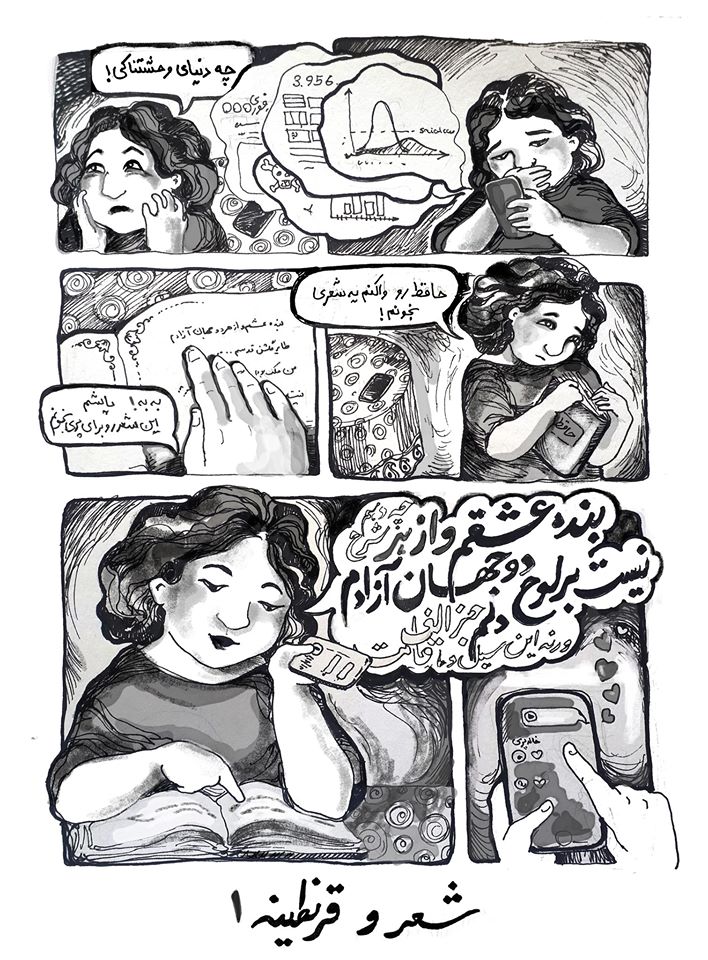
First frame: “How terrifying!”
Second frame: “Let’s open up Hafez and read a poem… How beautiful! Let me read this poem for Pari!”
Third frame: “Openly I admit, with much joy and glee! I am a slave to your love, and thus free from both worlds”
“The first time Parastoo sent me a voice message of herself singing Ahmad Shamlu’s poetry during the first week of quarantine, I was a little surprised. I thought it was a little soon to be reading poetry to each other. But that same night, I recorded myself reading Hafez for another friend. Little by little, reading poetry came to take the place of reading the news. As days passed, I realized that every single day I was sending friends recordings of poems, and in return I listened to their voices reading poems to me.
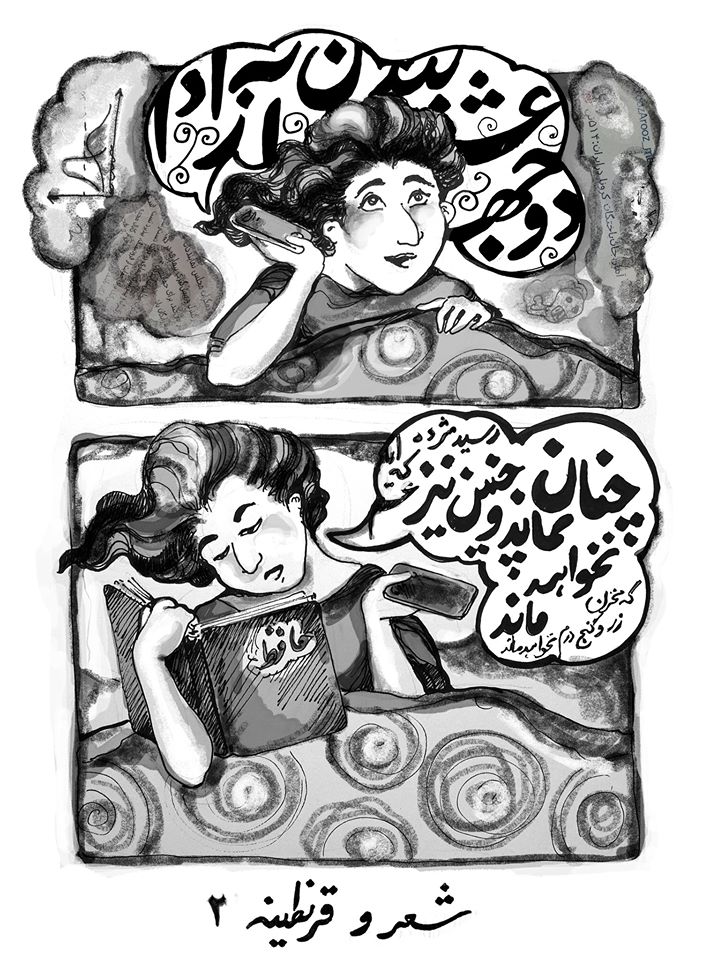
First frame: “Openly I admit, with much joy and glee! I am a slave to your love, and thus free from both worlds”
Second frame: “Good tidings have arrived so that the time of grief shall not remain, just as the time of joy does not last forever, neither does that of pain.”
“Poems about inevitability, distance, absence, and the illusion of a future no longer visible. Seeing from a distance the totality of a life now becoming constricted tighter and tighter into the four walls of an apartment. This separation, this absence, this sudden end of our lifestyles, this purgatory of quarantine, the melancholy of remaining at home and listening to oneself, this listening to the walls, listening to the neighbor’s walls, smelling the craziness, eating meals in an empty garden, and listening for the scattered sounds of fights coming from the tiny little apartments of Tehran- without poetry this will never be possible for us to endure.”

First frame: “Good tidings have arrived so that the time of grief shall not remain, just as the time of joy does not last forever, neither does that of pain.”
Second frame: “They say that with patience, stone turns to rubies. Oh that it does, but not without the blood of broken hearts.”
For Nafisi and her friends, reading poetry became a way to pass the time, to build bonds of collective solidarity, and to hear each others’ voices in the absence of physical proximity. Poetry readings, shared over voice messages on Whatsapp and Telegram, began to morph into something more expansive, something more collective.
“Spring arrived in Tehran,” Nafisi continued. “We couldn’t believe that spring arrived and yet we were stuck, unable to embrace our loved ones. We decided to write poems on banners, like those poems we read to each other over the phone, but this time for our neighbors. Our neighbors who were just as alone as we were amidst the coming of spring.”
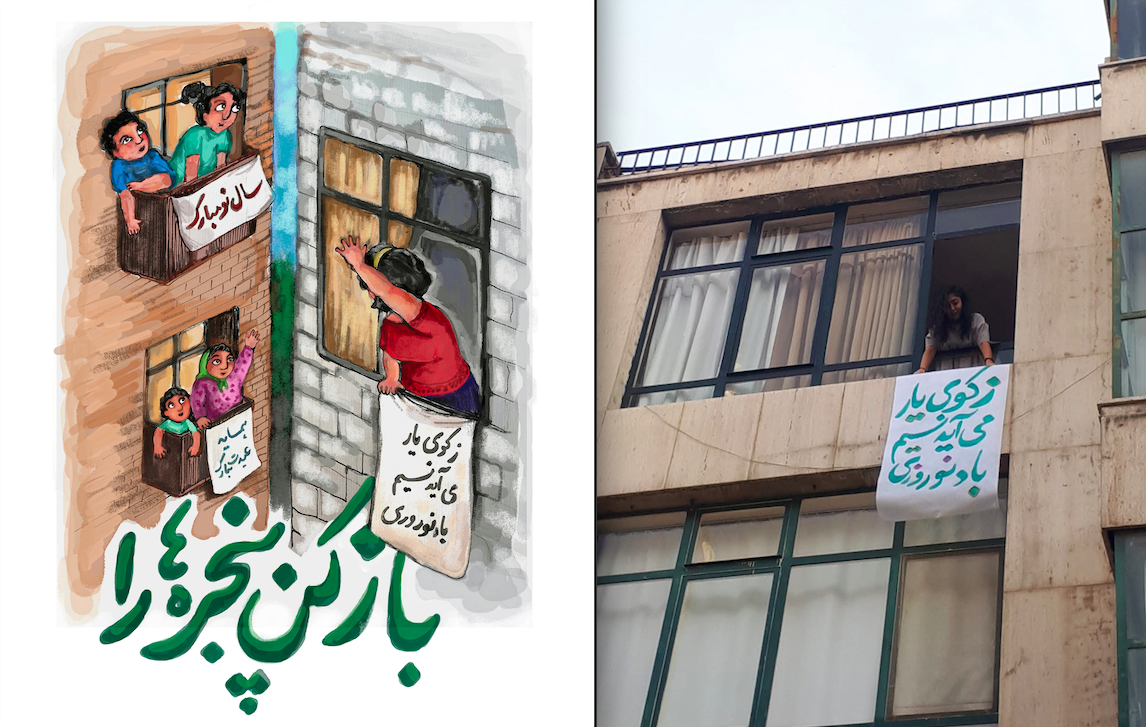
Beginning with a banner wishing a happy new year to her neighbor, she began making banners for her friends, taking their poems and turning them into banners to hang from their windows, to welcome spring and to greet their neighbors with well wishes for the year to come.
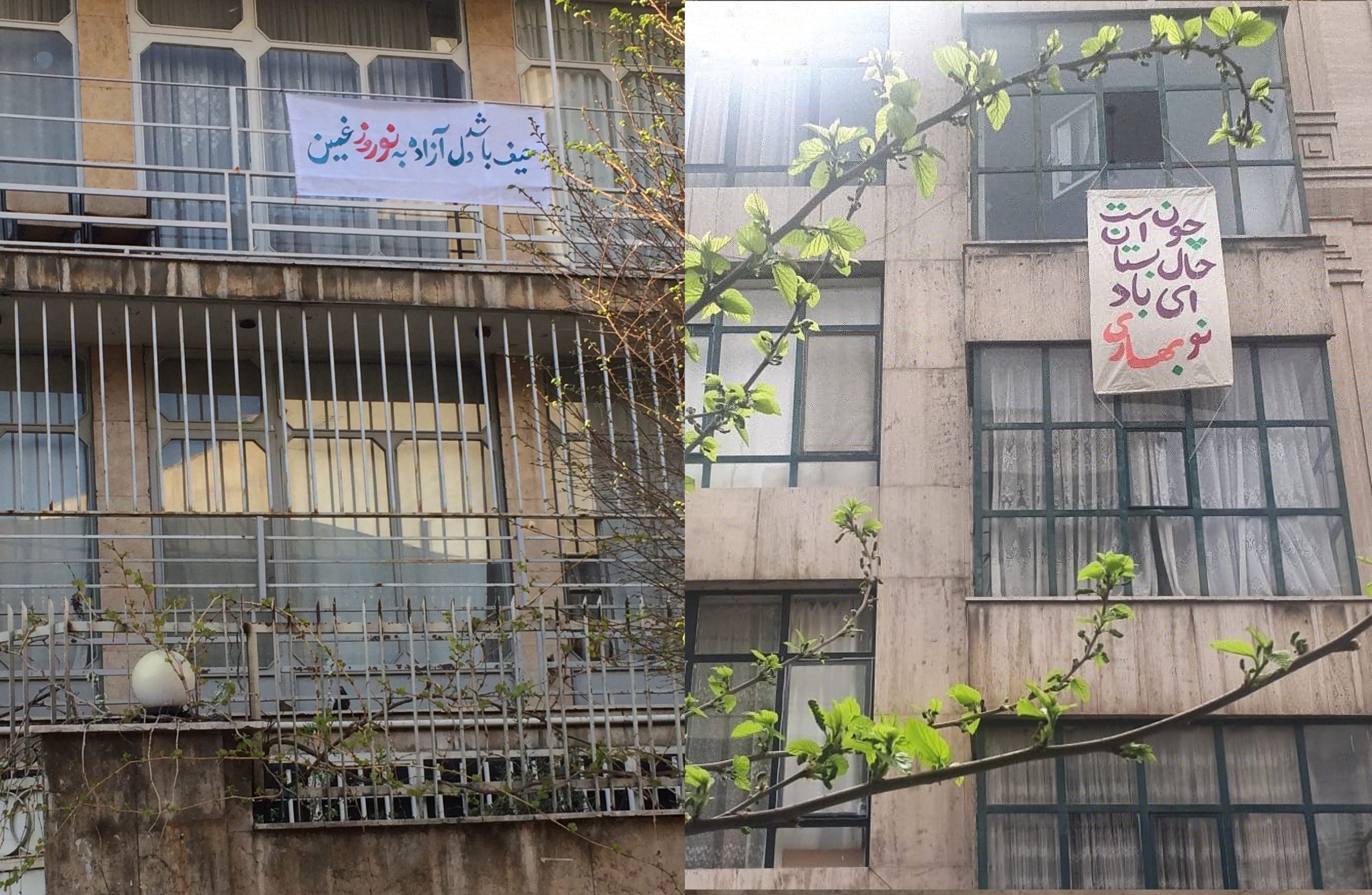
The banners began to appear in some of Tehran’s streets and alleys, one by one, hanging from the windows of apartments big and small, wishing joy and blessings upon all who saw them. Upon the millions of others living in Tehran who watched spring arrive from the four walls of an isolated quarantine.
As Nafisi put her banners up, other banners started popping up around town. Across Tehran, numerous other people had the same idea, or were inspired seeing banners popping up around them.
And suddenly, the idea spread: Nowruz would be welcomed with banners.
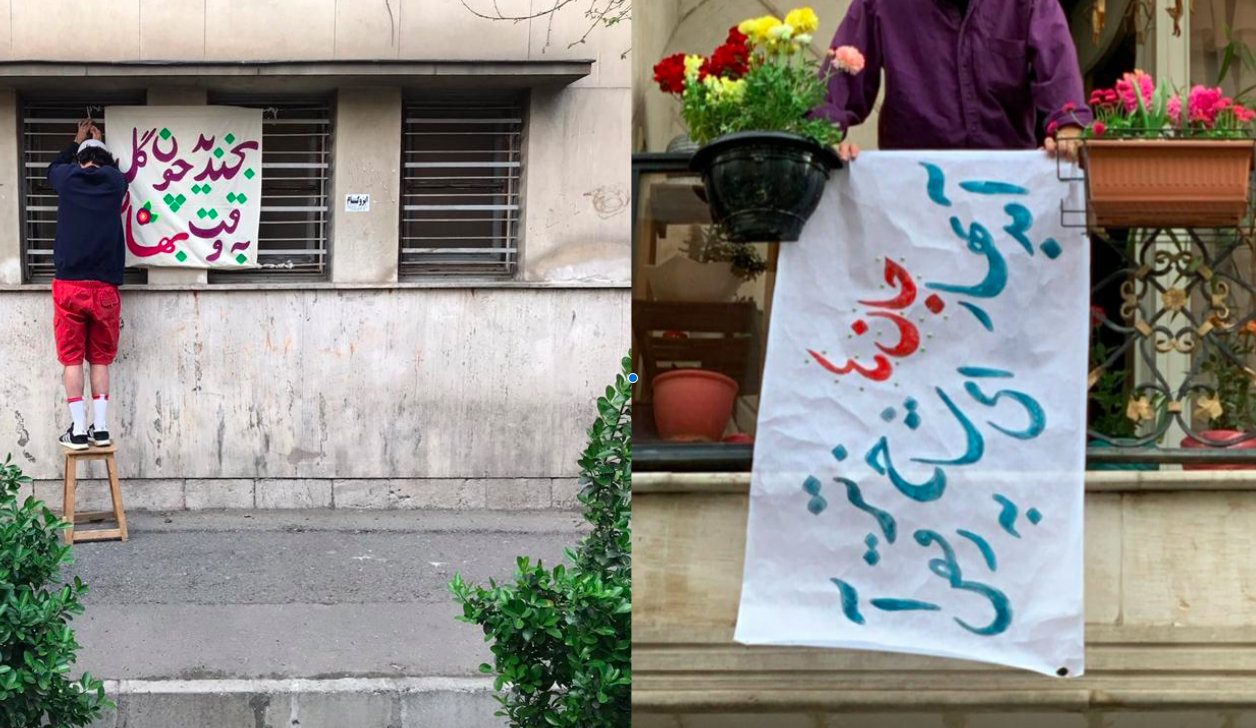
In these difficult days, where we find ourselves isolated in quarantine and fearful of human contact, perhaps these Nowruz banners can offer a glimpse of hope, of the possibility of solidarity between neighbors, between those who share a city, a home, and a world.
They are a reminder of how interconnected we are, as well as of the shared future we all have in the world that will come when quarantine finally ends.
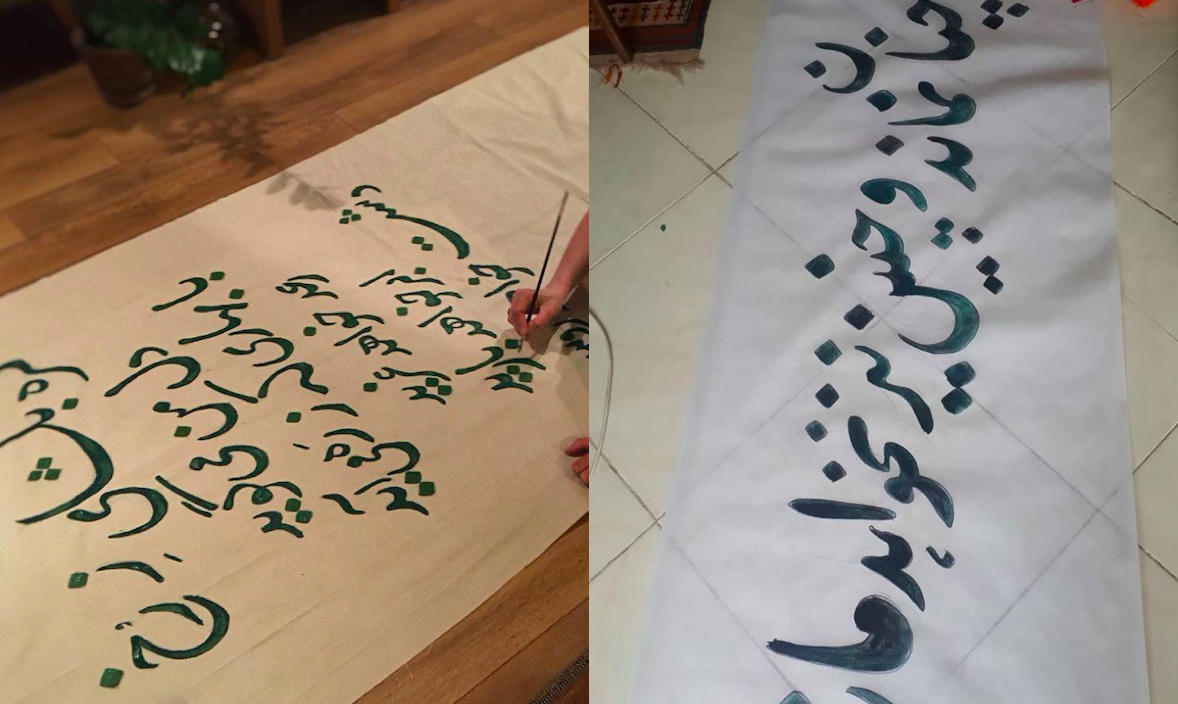
Nowruz has arrived, and spring with it. This year, we are forbidden from feeling its breeze except from the edge of our windows, forbidden from seeing its flowers except from behind a glass pane.
But the banners that have flourished across the city offer a sense of hope, that may maybe this quarantine is just temporary, that maybe soon life will return, a life even better than before. In the meantime, the banners give neighbors a chance to smile.
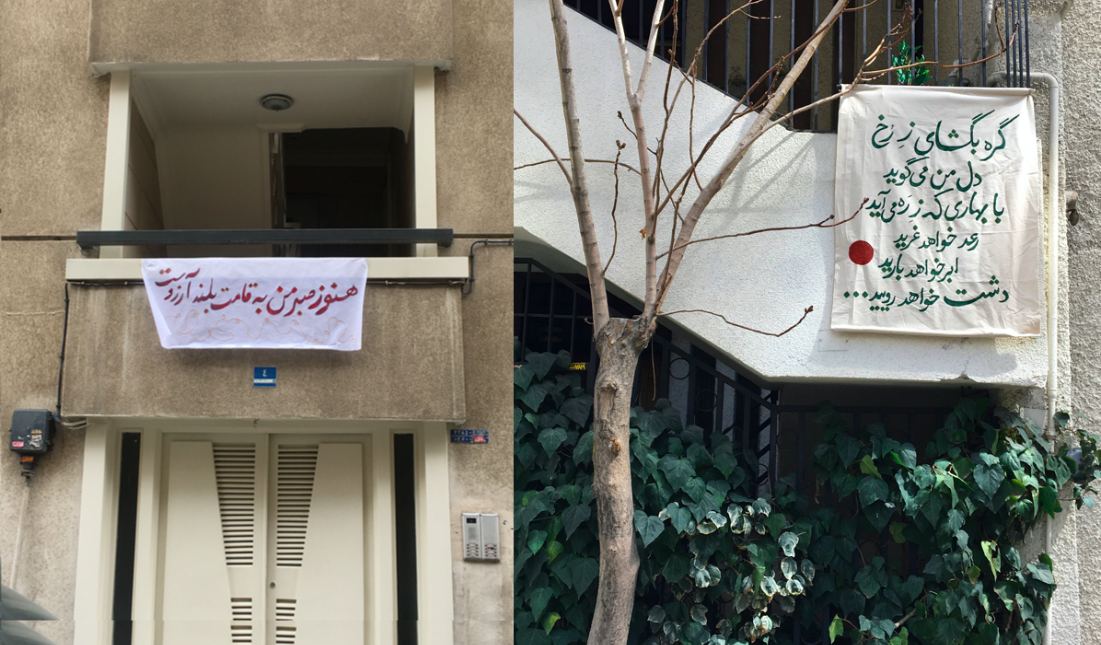
Under quarantine, Iranians invent new ways to celebrate the arrival of spring. Transforming their traditions, they build bonds of solidarity between neighbors and loved ones.
Whether its the candle bonfires of the Chaharshanbe Soori ritual, sharing poems with friends, or drawing banners to wish neighbors a happy new year, they remind us that this dystopia we find ourselves in will pass, and that our survival is inseparable from the survival of those around us.
Wishing you a happy first day of Spring, a blessed Nowruz, and a year full of love, joy, and health to come.
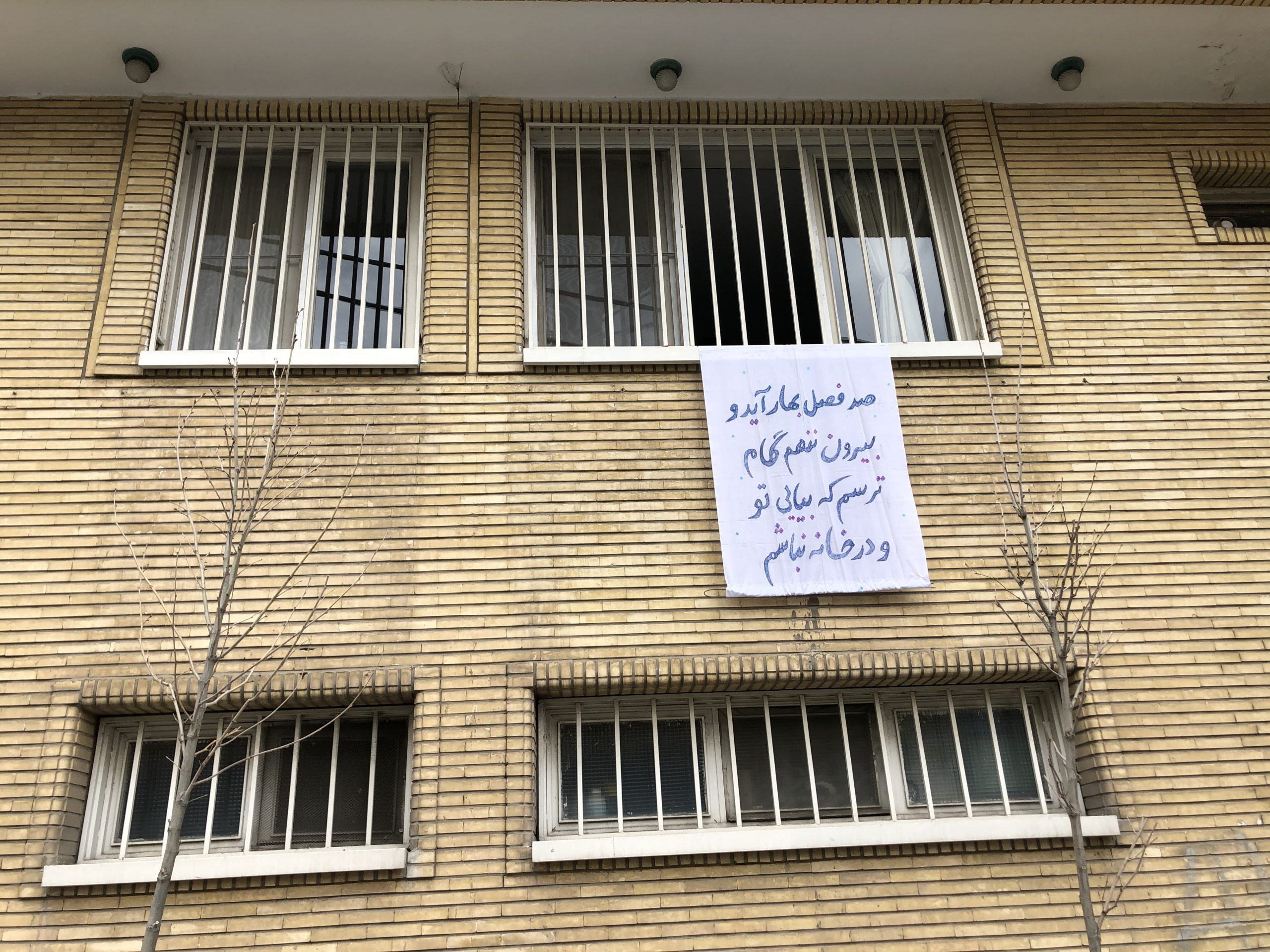














10 comments
Jigar Ajam enlightening write up.
Be safe. Be blessed.
Khushbash.
How wonderful. I definitely have to share this.
Dear Alex:
Thanks for this wonderful post. I want to share with you documentary called “Poetry as a daly experience in Iran” that we made in 2011, it is in Persian with subtitles in Spanish.
I hope you like it.
Here is the link: